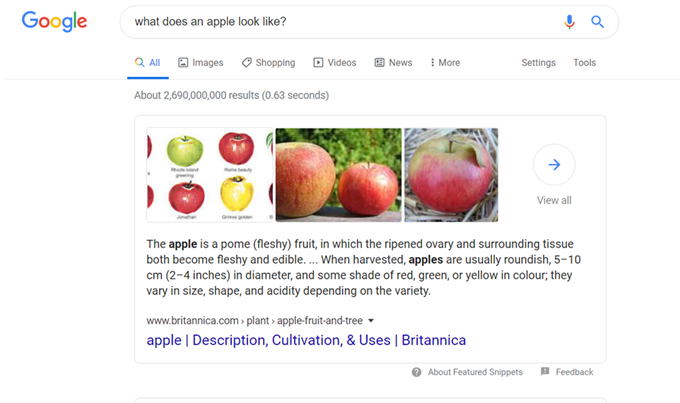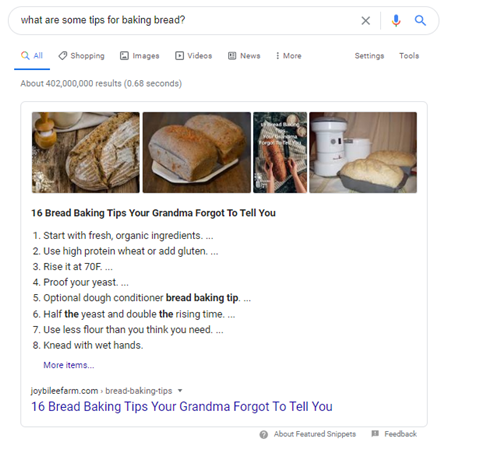How Changes to Google Featured Snippets Hurt SEO — and Why You Shouldn’t Care
In January 2020, Google removed listings selected as “featured snippets” from search engine response pages (SERPs) to avoid duplication and make SERPs more user-friendly. While SEO specialists worry that the move devalues the SEO benefits of snippets forever, marketers may not want to be so quick to abandon them. Featured snippets are prime real estate on a SERP after all. And they could be a smart investment for the future, given how voice search is growing.
Before you decide whether it’s worthwhile spending your time and energy trying to land a featured snippet on Google, let’s unpack what a featured snippet is and how it’s recently changed. Then, we’ll take a look at a few basic tips that could potentially help you get that top spot on a SERP.
What Is a Featured Snippet?
A featured snippet on Google is a snapshot of a first-page search result that the search engine decides is the most direct and concise answer to a user’s question. In other words, the featured snippet contains all the pertinent information that can answer the user’s basic question. The idea is that the information in a featured snippet is so relevant and to the point that the user may not need to click any further to learn more.
As an example, here’s a featured snippet that Google returned in response to the question, “What does an apple look like?”

A featured snippet in Google can appear as a paragraph, a list, or a table. But no matter the format, the featured snippet always appears in prime SERP real estate: a highlighted box set above the #1 ranked search response, aka “position zero.”
Position zero makes the featured snippet highly visible, which is why marketers have lusted after getting the featured snippet for years. A study of 1.4 million Google searches in 2017 determined that nearly a third of all Google results had featured snippets, up from only a fifth of all results just two years earlier.
No More “Two for One” Results with Featured Snippets
When Google decided to “declutter” SERPs this year, it removed the featured snippet’s organic ranked search listing, which appeared below the snippet itself. This took away a major benefit for marketers and SEO specialists: no more duplicate listing on the first SERP.
Does this change mean fewer click-throughs? It’s a point that has been hotly debated. And for many, the jury is still out on whether Google’s decision will have a major impact on “owning” the coveted featured snippet spot.
It stands to reason that if you’re the #1 ranked search result, and you lose that spot because you own the featured snippet, click-through rates will decrease. And research shows the #1 spot still achieves a higher click-through rate than the featured snippet. However, if you leap up to “position zero” from #4 or #5 in the search rankings, you may actually benefit.
So, perhaps tossing aside featured snippets completely is unwise. After all, trying to climb your way from #5 in the search rankings to #1 is a long and often tough slog. But with a strategic play to earn the featured snippet spot, your content could potentially leapfrog to the top position, nestled in a highlighted box in a tony neighborhood.
How to Get a Featured Snippet
So, how do you own the featured snippet? Alas, there’s no shortcut. You can’t pay for it. Also, you don’t have to be number one in your industry to land in the featured snippet box. What you do need is high-quality, user-friendly content. Essentially, you need to apply the tried and tested ways of maximizing search and, in Google’s own words, do what it takes to provide users with “a concise, direct answer” to their question.
Ready for the challenge? Here are some pointers for increasing your chances of earning a featured snippet spot in Google search results. You’ll notice that most of these tips will require a little time, elbow grease, and experimentation to get results:
1. Do your homework
First, search the query you want to develop content for and see what Google returns as the featured snippet. Then, try to align your content with the information presented in the snippet.
Featured snippets are often served up as responses to question-based queries, such as, “What are some tips for baking bread?” So, keep this in mind when framing your content.

2. Dig in on keywords
This is basic advice, yes, but it’s essential: You need to research keywords for your topic or product and use them well. There are a variety of tools you can employ for keyword research, and some are even free. (This post lists a few examples of free options.)
Also, research by ahrefs suggests that “‘long-tail keywords” — typically unpopular four- or five-word phrases — are more likely to trigger featured snippets. (By the way, that same study found that about 12% of search queries have featured snippets in their search results. When you’re talking about millions of search results, that’s a pretty attractive percentage.)
3. Be diligent about good SEO practices
If Google can’t readily find your content, it’s unlikely that it will end up in a featured snippet or even on the same page with a featured snippet. So, you need to adhere to good SEO practices, period. Break up your copy with the use of subheads, tables, and graphics and make sure your coding is correct with the proper tags. Text blocks of between 54 and 58 words work best.
4. Make content useful and engaging
Google favors high-quality content: specific, relevant, informative, and user-friendly. Follow these guidelines and Google will be more likely to “snip” your content. Just be careful not to write your content for the search engine — always write it with users in mind. Getting a featured snippet won’t be worth the time and effort if your users discover that your content really doesn’t answer their question, or if you attract the wrong audience for your content altogether.
5. Don’t leave images up to chance
As they say, a picture paints a thousand words. So, don’t leave the images that may be displayed with your content in featured snippets up to chance.
In most cases, Google adds a graphic alongside the text of the featured snippet. (This is less common in lists or tables.) If you don’t have an image on your page, make sure to include one. Without an image, Google’s algorithm is likely to pull one from another page. You could end up with an irrelevant or off-brand image (or a competitor’s image!), and you don’t want that.
Once you publish your content, monitor your ranking and follow the metrics. If you don’t see immediate success in the form of a featured snippet, that doesn’t necessarily mean going back to the drawing board. Tinker with the page, try out new keywords and see what works.
Look to the Future
There is one final thing to consider as you assess whether owning the featured snippet will help your SEO and therefore, your brand identity and marketing. The future of voice search.
According to Comscore, about 50% of search queries today are conducted through voice-enabled devices, namely voice assistants like Siri and Google Assistant. This trend will only expand, with more people looking to smart speakers, smart displays, wearables, gaming consoles, and even their cars as convenient tools for searching for information on the internet.
Digital & Social Articles on Business 2 Community
(43)

